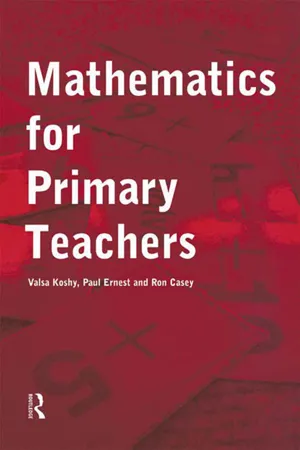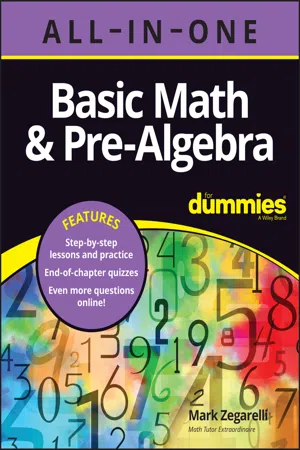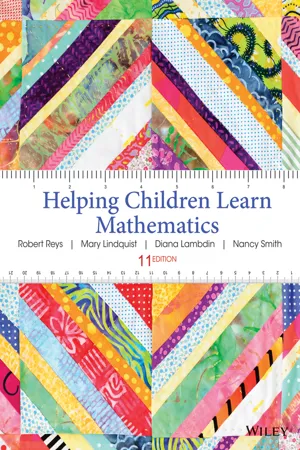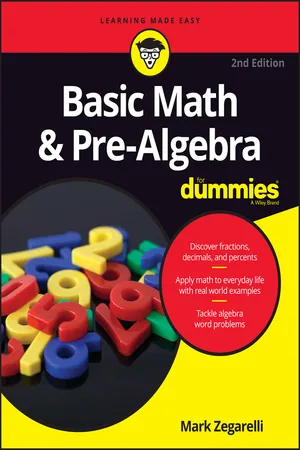Mathematics
Fractions, Decimals and Percentages
Fractions, decimals, and percentages are different ways of representing parts of a whole. Fractions express a part of a whole as a ratio of two numbers, decimals represent the same information in a different format, and percentages are a way of expressing a fraction or a decimal as a portion out of 100. These concepts are fundamental in understanding and working with numbers.
Written by Perlego with AI-assistance
Related key terms
1 of 5
12 Key excerpts on "Fractions, Decimals and Percentages"
- eBook - ePub
- Valsa Koshy, Ron Casey, Paul Ernest, Valsa Koshy, Ron Casey, Paul Ernest(Authors)
- 2014(Publication Date)
- Routledge(Publisher)
Chapter 3 Fractions, Decimals and PercentagesDOI: 10.4324/9780203984062-5This chapter focuses on:- 3.1 Fractions
- 3.2 Decimals
- 3.3 Indices
- 3.4 Standard index form
- 3.5 Percentages
3.1 Fractions
In the progression of mathematics topics presented to children, the study of fractions can be the first departure from the restriction to the positive integers, which are usually referred to as whole numbers. A fraction is usually introduced as a concept enabling reference to be made to ‘a part of a whole’.For example, 3/8 can be thought of as three parts of a whole one which has been split into eight equal parts. A diagram can be used to illustrate this particular fraction.What if the top number of the fraction is an integer (whole number) greater than the bottom number of the fraction? Does this undermine the notion of a fraction being ‘a part of a whole’ ? Two examples will illustrate an appropriate answer to this question.Consider first the fraction 18/3. Its top number is greater than its bottom number. A diagram could be used to give an interpretation of this fraction.Each unit (whole) is split into three equal parts. One of those parts, in the left-most unit, is shaded. That shaded part represents 1/3. In the entire diagram there are 18 such thirds. Those 18 thirds, therefore, represent 6 units. So 18/3 = 6.What about 18 divided by 3? That is also equal to 6. So the fraction 18/3 may be interpreted in two ways:- it may be thought of as eighteen thirds or
- it may be thought of as 18÷3.
For example, if you have eighteen sweets to share between three children then your situation requires you to think of 18/3 as 18 ÷ 3. As division is repeated subtraction, you are in principle taking away three from eighteen six times, so each child gets six sweets. This illustration gives some justification for sometimes calling division by another term ‘sharing’ as well as sometimes calling subtraction by its alternative ‘taking away’. - eBook - ePub
Math Makes Sense!
A Constructivist Approach to the Teaching and Learning of Mathematics
- Ana Helvia Quintero, Héctor Rosario(Authors)
- 2016(Publication Date)
- ICP(Publisher)
the number of decimal places of the product is equal to the sum of the decimal places of the factors . This leads to the rule of multiplication of decimals:(1)Multiply both decimal numbers as if they were integers and place a decimal point at the end. (2)Add the decimal places of the two multiplicands. (3)In the number obtained in step 1, move the decimal point — from right to left — the number of places given by step 2. The resulting number will be the product of the two original numbers. Students should do operations with decimals just to learn the rules, not to become adept at multiplying excessively long numbers; those should be worked with calculators.6.9.3 Relating decimals to other fraction representationsDuring fifth and sixth grade (10–12 years), we introduce problems that require associating decimals with fractions and percentages. For example, when working on the number line, we observe equivalencies:It is important for students to see the relationship between fractions and decimals. One analogy that helps in this process is money. Consider the following table.
Number line representations also give us a way to visualize these relations.Money Decimal Fraction 50 cents 0.50 1/2 (of a dollar) 25 cents 0.25 1/4 (of a dollar) 10 cents 0.10 1/10 (of a dollar) 6.10 Percentages
In fifth grade (10–11 years), we introduce the idea of percentages. A percentage is a ratio. To say that 30% of the group participated in an activity is the same as saying that a proportion equivalent to 30 out of 100 participated. It is important to relate percentages to fractions and, from there, to the part–whole idea. Later, after percentages are introduced, we integrate problems that associate them with fractions and decimals. - Sandra Rush(Author)
- 2013(Publication Date)
- Research & Education Association(Publisher)
3The Parts of the Whole
Decimals, fractions, and percentages are all closely related. For example, to say that 5 is half of 10 can be represented as .50 × 10, ½ of 10, or 50% of 10. This chapter discusses each of these types of calculations in detail.Decimals
The four operations on decimals are essentially the same as for whole numbers with special attention given to the placement of the decimal point in the answer. Zeros can be filled in as placeholders to the left of a whole number (00123 is the same as 123), or to the right of a decimal (.45600 is the same as .456).The word decimal comes from the Latin word that means “10.” Our counting system (as we saw in Chapter 2 ) as well as our monetary system are based on the number 10. Just as our placeholders were ones, tens, hundreds, and so forth, for whole numbers, decimals indicate parts of units, with placeholders of tenths, hundredths, thousandths, and so on. The decimals appear after a decimal point (.) and get smaller as the numbers go to the right.CALCULATOR BASIC ARITHMETICThe important keys for addition, subtraction, multiplication, and division are the parentheses keys and above the number pad, as well as .For addition, enter the first number, then , then the next number, etc., then .For subtraction, enter the first number, then , then the next number, etc., then .For multiplication, enter the first number, then , then the next then . The multiplication sign on the screen will change to *.For division, enter the dividend (the number that is to be divided, or the numerator, the top number on a fraction), then , then the divisor (the number being divided into the dividend, or the denominator, the bottom number on a fraction), then .For any of the operations or any combination of operations, if any of the entries involve more than one term or factor, use parentheses or the answer might not be correct. For example, if you want to multiply 6 × (2 – 5), enter it just that way, with the parentheses, and press . The answer is – 18. The superscripted minus sign means it belongs to the number following it. If this calculation is entered without the parentheses, as- eBook - PDF
Mathematics for Elementary Teachers
A Contemporary Approach
- Gary L. Musser, Blake E. Peterson, William F. Burger(Authors)
- 2013(Publication Date)
- Wiley(Publisher)
Compare and order fractions, decimals, and percents efficiently and find their approximate locations on a number line. Develop meaning for percents greater than 100 and less than 1. Understand and use ratios and proportions to represent quantitative relationships. Understand the meaning and effects of arithmetic operations with fractions, decimals, and integers. Use the associative and commutative properties of addition and multiplication and the distributive property of multi- plication over addition to simplify computations with integers, fractions, and decimals. Develop and analyze algorithms for computing with fractions, decimals, and integers and develop fluency in their use. Develop, analyze, and explain methods for solving problems involving proportions, such as scaling and finding equiva- lent ratios. Key Concepts from the NCTM Curriculum Focal Points GRADE 2: Developing an understanding of the base ten numeration system and place-value concepts. GRADE 4: Developing an understanding of decimals, including the connections between fractions and decimals. GRADE 5: Developing an understanding of and fluency with addition and subtraction of fractions and decimals. GRADE 6: Developing an understanding of and fluency with multiplication and division of fractions and decimals. GRADE 7: Developing an understanding of and applying proportionality, including similarity. Key Concepts from the Common Core State Standards for Mathematics GRADE 4: Understand decimal notation for fractions, and compare decimal fractions. GRADE 5: Understand the place value system for decimals to the thousandths place. Perform operations with decimals to hundredths. GRADE 6: Compute fluently with multi-digit numbers (including decimals). Understand ratio concepts and use ratio reasoning to solve problems. GRADE 7: Analyze proportional relationships and use them to solve real-world and mathematical problems. - eBook - PDF
- Robert Reys, Mary Lindquist, Diana V. Lambdin, Nancy L. Smith, Anna Rogers, Audrey Cooke, Bronwyn Ewing, Kylie Robson(Authors)
- 2021(Publication Date)
- Wiley(Publisher)
To make sense of the relationship between fractions and decimals, children need to understand the quotient meaning of fractions or be able to make equivalent fractions with denominators of 10 or 100. This is a very useful skill when working with percentages. For example, 4 5 means four divided by five. The fraction four-fifths is also equivalent to eight-tenths, the decimal 0.8, or eighty-hundredths. To divide four by five, children need to know that four is equivalent to 4.0 and dividing by five will lead to a decimal answer. Helping children gain these understandings will be most valuable, either using digital technology or a traditional method. Children can use the quotient meaning of a fraction to change any fraction to a decimal (or a decimal approximation). A common mistake however can be illustrated by the fraction 1 3 . It can be interpreted as 0.3, 0.33, 0.333, 0.3333 or other values. These are all approximations, as they will never multiply back by three to give one whole, since one-third is a recurring decimal. Children can explore many interesting patterns where fractions yield recurring decimals. These can be investigated with digital technology or calculated by hand. The difference will be that the number of decimal places that result on a calculator are limited by the display. Some fractions when converted to decimals go on infinitely. For example, the decimal approximations for ninths are: 1 9 = 0.11111 2 9 = 0.22222 3 9 = 0.33333 and more! N.B. Mathematicians write one recurring decimal number with a dot above the digit. Children might like to do a few of these calculations by hand to show that the pattern continues forever. Denominators that are prime numbers (if whole) are worthy of exploration. Have a try with elevenths and describe the pattern you found. An excellent investigation with decimals is the sevenths. The fractions as a decimal create a loop of six digits which repeats forever. - Mark Zegarelli(Author)
- 2022(Publication Date)
- For Dummies(Publisher)
Percentages and decimals are similar ways of expressing parts of a whole. This similarity makes converting percentages to decimals, and vice versa, mostly a matter of moving the deci- mal point. It’s so simple that you can probably do it in your sleep (but you should probably stay awake when you first read about the concept). Percentages and fractions both express the same idea — parts of a whole — in different ways. So converting back and forth between percentages and fractions isn’t quite as simple as just moving the decimal point back and forth. In this section, I cover the ways to convert to and from percentages, decimals, and fractions, starting with percentages to decimals. Converting Percentages to Decimals Percentages and decimals are very similar forms, so everything you know about decimals (see Chapter 13) carries over when you’re working with percentages. All you need to do is convert your percent to a decimal, and you’re good to go. To change a whole-number percent to a decimal, simply replace the percent sign with a deci- mal point and then move this decimal point two places to the left; after this, you can drop any trailing zeros. Here are a few common conversions between percentages and decimals: 100 1 75 0 75 50 0 5 25 0 25 20 0 2 10 0 1 % % . % . % . % . % . = = = = = = Sometimes a percent already has a decimal point. In this case, just drop the percent sign and move the decimal point two places to the left. For instance, 12 5 0 125 . % . = . Q. Change 80% to a decimal. A. 0.8. Replace the percent sign with a decimal point — changing 80% to 80.0 — and then move the decimal point two places to the left: 80 0 80 % . = At the end, you can drop the trailing zero to get 0.8. Q. Change 37.5% to a decimal. A. 0.375. Drop the percent sign and move the decimal point two places to the left: 37 5 0 375 . % . = 288 UNIT 5 Decimals and Percents 1 Change 90% to a decimal. 2 A common interest rate on an investment such as a bond is 4%.- eBook - ePub
Making Number Talks Matter
Developing Mathematical Practices and Deepening Understanding, Grades 3-10
- Cathy Humphreys, Ruth Parker(Authors)
- 2023(Publication Date)
- Routledge(Publisher)
Without understanding fractional relationships, students have only their memories to fall back on, and, as Van de Walle and Lovin (2006) point out, “When mixed together, the myriad rules for fractions computation become a meaningless jumble” (88). Students’ understanding of decimals and percent has met a similar fate; rules about moving decimal points—which ones to move, how many places, and which direction—become so muddled in many students’ minds that the quantities involved are lost. This chapter, therefore, has a different goal and structure than the chapters on whole-number operations. Because understanding fractional relationships supports understanding of both decimals and percent, we devote most of the chapter to ideas for supporting students’ understanding of fractions. Then we look briefly at how some of those same ideas apply and extend to decimals. Finally, there is a short section on understanding percent and finding the percent of a number. Thinking About Fractions Our primary goal in the following Number Talks is to shore up the fragile understanding that most upper-grade students have about what fractions mean. Students whose experiences have been primarily procedural—which at this time means probably most of our students—have gotten into the habit of viewing a fraction as two unrelated numbers (the numerator and denominator) rather than as one number: a relationship between those two quantities. Katie, for example, didn’t think about ¾ as a quantity that is a little less than 1; she saw the 3 and the 4 as discrete and unrelated numbers. This unfortunate tendency can be directly traced to the traditional algorithms for addition, subtraction, multiplication, and division of fractions that teach students to act on numerators and denominators separately - eBook - ePub
- Marcus Witt, Marcus Witt, Author(Authors)
- 2014(Publication Date)
- Learning Matters(Publisher)
6 Fractions, Decimals, Percentages, Ratio and Proportion Alice Hansen Jonathan LeemingLearning Outcomes
This chapter aims to develop your understanding of:- fractions, decimals, percentages, ratio and proportion;
- the relationship between fractions, decimals, percentages, ratio and proportion;
- how to teach fractions, decimals, percentages, ratio and proportion effectively.
Teachers' Standards
- 1 Set high expectations which inspire, motivate and challenge pupils.
- 2 Promote good progress and outcomes by pupils.
- 3 Demonstrate good subject and curriculum knowledge.
- 4 Plan and teach well-structured lessons.
- 6 Make productive and accurate use of assessment.
Introduction
In this chapter you will explore what fractions, decimals, percentages, ratio and proportion (FDPRP) are, why they are important and how you can teach them effectively.FDPRP are presented together in this chapter because of their interconnected nature. However, the majority of this chapter will focus on fractions because they are one of the most difficult aspects of mathematics to understand and teach, and fractions dominate this section of the Primary National Curriculum. Then, in turn, decimals, percentages, and ratio and proportion will be discussed.Fractions
Research Focus: The Importance of Teaching Fractions in Primary School
Siegler et al. (2012) carried out a longitudinal study to examine the predictors of secondary school students’ achievement in mathematics. They found that, in the UK, the strongest predictor of mathematical performance at 16 was pupils’ understanding of fractions and division when they were ten years old. This was greater than the contributions of whole number arithmetic knowledge, verbal and non-verbal IQ, working memory, and family education and income. Siegler et al. suggest improving the teaching and learning of fractions in primary school could yield ‘substantial improvements’ in later mathematics. - eBook - PDF
- Robert Reys, Mary Lindquist, Diana V. Lambdin, Nancy L. Smith(Authors)
- 2014(Publication Date)
- Wiley(Publisher)
These percents should be illustrated with a variety of different situations and models. For example, a rope with 100 disks arranged in multiples of 10 in alternating colors shows 50% of each color. • Can a price increase 150%? • Can a price decrease 50%? • Can a price decrease 100%? • Can a price decrease 150%? Ironically, the understanding of percent requires no new skills or concepts beyond those used in mastering fractions, decimals, ratios, and proportions. In fact, percent is not really a mathematical topic, but rather the application of a particu- lar type of notational system. The justification for teaching percent in school mathematics programs rests solely on its social utility. As is true with decimals and fractions, percents express a relationship between two numbers. Percents are special ratios based on 100 and without a doubt are the most widely used of all ratios. Percent is derived from the Latin words per centum, which mean “out of a hundred” or “for every hundred.” The origin of percent and its major uses are close- ly associated with ratios, fractions, and decimals. Thus, 25% is the ratio 25:100 or 25 100 , which then connects to decimals (0.25) and the fraction 1 4 . When is percent understood? Students understand per- cent when they can use it in many different ways. For instance, if a child understands 25%, he or she can do the following tasks. • Find 25% in various contexts: Cover 25% of a floor with tiles. Determine 25% off the price of a given item. Survey 25% of the students in class. In many such situations, estimates of 25% are not only ap- propriate but essential. • Identify characteristics of 25%: 25% of the milk in a glass is less than half. If 25% of a glass is spilled, then 75% remains. • Compare and contrast 25% with a range of other percents and numbers such as 5%, 50%, 100%, one-fourth, one-half, and 0.25. - eBook - PDF
- (Author)
- 2015(Publication Date)
- For Dummies(Publisher)
It’s so simple you can probably do it in your sleep (but you should probably stay awake when you first read about the concept). Percentages and fractions both express the same idea — parts of a whole — in different ways. So converting back and forth between percentages and fractions isn’t quite as simple as just moving the decimal point back and forth. In this section, I cover the ways to convert to and from percentages, decimals and fractions, starting with percentages to decimals. Going from percentages to decimals To convert a percentage to a decimal, drop the per cent sign (%) and move the decimal point two places to the left. It’s simple as you are actually dividing by 100. Remember that, in a whole number, the decimal point comes at the end. For example, = = = = 2.5% 0.025 4% 0.04 36% 0.36 111% 1.11 90 Part I: Reviewing the Basics Changing decimals into percentages To convert a decimal to a percentage, move the decimal point two places to the right as you are actually multiplying by 100, and add a per cent sign (%): = = = 0.07 7% 0.21 21% 0.375 37.5% Switching from percentages to fractions Converting percentages to fractions is fairly straightforward. Remember that the term ‘per cent’ means ‘out of 100’. So changing percentages to fractions naturally involves the number 100. To convert a percentage to a fraction, use the number in the percentage as your numerator (top number) and the number 100 as your denominator (bottom number): = = = 39% 39 100 86% 86 100 217% 217 100 As always with fractions, you may need to reduce to lowest terms or convert an improper fraction to a mixed number. In the three examples, 39 100 can’t be reduced or converted to a mixed number. - eBook - ePub
- Mark Zegarelli(Author)
- 2016(Publication Date)
- For Dummies(Publisher)
Chapter 13 , when I show you how to do word problems involving percents.Converting to and from Percents, Decimals, and Fractions
To solve many percent problems, you need to change the percent to either a decimal or a fraction. Then you can apply what you know about solving decimal and fraction problems. For this reason, I show you how to convert to and from percents before I show you how to solve percent problems.Percents and decimals are similar ways of expressing parts of a whole. This similarity makes converting percents to decimals, and vice versa, mostly a matter of moving the decimal point. It’s so simple you can probably do it in your sleep (but you should probably stay awake when you first read about the concept).Percents and fractions both express the same idea — parts of a whole — in different ways. So converting back and forth between percents and fractions isn’t quite as simple as just moving the decimal point back and forth. In this section, I cover the ways to convert to and from percents, decimals, and fractions, starting with percents to decimals.Going from percents to decimals
To convert a percent to a decimal, drop the percent sign (%) and move the decimal point two places to the left. It’s simple. Remember that, in a whole number, the decimal point comes at the end. For example,Changing decimals into percents
To convert a decimal to a percent, move the decimal point two places to the right and add a percent sign (%):Switching from percents to fractions
Converting percents to fractions is fairly straightforward. Remember that the word percent - eBook - PDF
Arithmetic For Parents: A Book For Grown-ups About Children's Mathematics (Revised Edition)
A Book for Grown-Ups About Children's Mathematics
- Ron Aharoni(Author)
- 2015(Publication Date)
- World Scientific(Publisher)
50% are 50 hundredths, namely, a half. 100% are 100 hundredths, namely, a whole. 0.1% is a tenth of a hundredth, that is, a thousandth. This tool enables us, among other things, to easily compare fractions. For example, saying that the unemployment rate in Israel is 10.3% and in Greece it is 11.5% allows us to realize straight away where the unemployment rate is higher. Lo and behold! The wolf shall dwell with the lamb! Why didn’t anyone think of this before? Isn’t there some sort of catch? A Number to Fit Man’s Measurements Well, the truth is that the invention of percentages isn’t that ingenious. It doesn’t contain any new mathematical idea, only practical advantages. Percentages aren’t that different from decimal fractions. For example, 24% 176 Arithmetic from First to Sixth Grades 177 just means 24 hundredths, that is, 24 100 or 24 ÷ 100, which is 0.24. Anything that can be written as percentages can also be written as decimal fractions. If so, what’s so useful about the invention of percentages? The advantage of percentages lies in the fact that, for many practical uses, they constitute a measurement tool with just the right degree of fineness. The choice of the universal common denominator wasn’t entirely arbitrary. To facilitate calculations such a denominator must be a power of 10 — the basic fraction must be 1, or 1 10 , or 1 100 , or 1 1000 , and so forth. It turns out that of all of these, dividing into hundredths is most suitable for the measurements people use. In many cases, it has exactly the required degree of fineness. For example, the results of an election usually require more accuracy than that provided by tenths, but hundredths are sufficient. If Candidate A received 44% of the votes, and Candidate B 41%, in the language of tenths both would be rounded off to 4 10 , and we wouldn’t know who won. The accuracy provided by percentages is also adequate for purposes of income tax, or sales tax, which is usually defined as whole percents.
Index pages curate the most relevant extracts from our library of academic textbooks. They’ve been created using an in-house natural language model (NLM), each adding context and meaning to key research topics.











